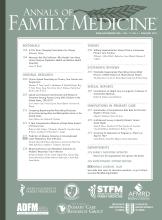Abstract
BACKGROUND Clinicians are faced with a plethora of guidelines. To rate guidelines, they can select from a number of evaluation tools, most of which are long and difficult to apply. The goal of this project was to develop a simple, easy-to-use checklist for clinicians to use to identify trustworthy, relevant, and useful practice guidelines, the Guideline Trustworthiness, Relevance, and Utility Scoring Tool (G-TRUST).
METHODS A modified Delphi process was used to obtain consensus of experts and guideline developers regarding a checklist of items and their relative impact on guideline quality. We conducted 4 rounds of sampling to refine wording, add and subtract items, and develop a scoring system. Multiple attribute utility analysis was used to develop a weighted utility score for each item to determine scoring.
RESULTS Twenty-two experts in evidence-based medicine, 17 developers of high-quality guidelines, and 1 consumer representative participated. In rounds 1 and 2, items were rewritten or dropped, and 2 items were added. In round 3, weighted scores were calculated from rankings and relative weights assigned by the expert panel. In the last round, more than 75% of experts indicated 3 of the 8 checklist items to be major indicators of guideline usefulness and, using the AGREE tool as a reference standard, a scoring system was developed to identify guidelines as useful, may not be useful, and not useful.
CONCLUSION The 8-item G-TRUST is potentially helpful as a tool for clinicians to identify useful guidelines. Further research will focus on its reliability when used by clinicians.
Footnotes
Conflicts of interest: A.F.S., J.L., and L.C. have published research evaluating clinical practice guidelines and a commentary advocating for more rigorous oversight of guideline development and dissemination.
Funding support: The research included in this article was supported by an RO3 grant funded by the Association for Healthcare Research and Quality (Grant No. R03HS022940-01A1).
Previous presentation: Guideline International Network Scientific Programme; August 20, 2015; Amsterdam, the Netherlands.
Supplementary materials: Available at http://www.AnnFamMed.org/content/15/5/413/suppl/DC1/.
- Received for publication October 24, 2016.
- Revision received February 6, 2017.
- Accepted for publication March 16, 2017.
- © 2017 Annals of Family Medicine, Inc.







